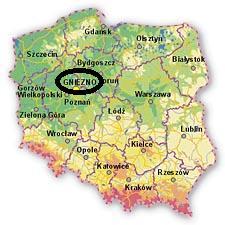Begginings of Polish country
All who want to acquaint with the beginning of o Poland and the beginning of the Christian faith in Poland are cordialy invited to Gniezno, the First Capital of Poland and the City of St. Adalbert. It was here that legendary Lech bade his brothers Czech and Rus farewell, and stayed here to found on a hill the first city.
To all the Poles Gniezno is the town which has a special place in the history of the Polish State. Here our statehood was born and grew in power, here we find the foundations of christianity. Gniezno was the first capital - the seat of Polish rulers. In the Cathedral the body of St. Adalbertus was buried, it was laid in the tomb Emperor Otto III made a pilgrimage to in the year 1000. Possesing the relics of the Martyr made it easier for prince Boleslaus The Brave to endeavour to have a metropolis created, which was an indispensable condition to gain the crown for the ruler. The realization of those endeavours caused the cathedral of Gniezno to become the coronational aula of the Polish kings, and the metropolitan of Gniezno became the only legal person to crown the kings. Here there took place the first synod during which the metropolis of Gniezno was announced, created by Pope Sylvester II, embracing with its borders the Polish State of those times. The importance of Gniezno grew in the beginning of XV century when the archbishop of Gniezno first obtained the title of The Primate of Poland, and 100 years later the title of a born lagate, since the first interreign the archbishop of Gniezno acted as interrex and styled himself the prince of the Polish Kingdom.
Look at the map to check its location:) near to Bydgoszcz,Torun and Poznan. Gniezno is circled by a black ring.
 The figure of St. Adalbertus, the main patron of Poland was one of very important factors integrating the Poles in the period of the country being devided into districts, and Gniezno was the place of many a pilgrimage deepening Polish identity. More clear-sighted studies over the life and activity of The Saint presented this figure in a new light, extraordinarily rich and colourful in the political, religious and cultural landscape of the Medieval Europe.
The figure of St. Adalbertus, the main patron of Poland was one of very important factors integrating the Poles in the period of the country being devided into districts, and Gniezno was the place of many a pilgrimage deepening Polish identity. More clear-sighted studies over the life and activity of The Saint presented this figure in a new light, extraordinarily rich and colourful in the political, religious and cultural landscape of the Medieval Europe.Beneath you have contemporary views of Cathedral in Gniezno:



Life of saint Adalbert (saint Wojciech)
He was born around the year 956 in the seat of the family of Slavnikovits in the Chec Libice. He spent his childchood at his parents' court, and then for ten years he was educated in Magdeburg in the school which enjoyed fame because of high level of teaching achieved thanks to the endeavours of Benedictine Octryk. Here he was administered the sacrament of confirmation and acquired his second christian name - in honour of his Patron archbishop of Magdeburg - Adalbertus. In the year 981 he returned to the Checs. After the death of the bishop of Prague Dytmar in the year 982, perhaps as the result of an agreement concluded between two families. Przemyslids and Slavnikovits, rivalling for the hegemony over the Chec country- he was elected the bishop of Prague on February 19th that year.
